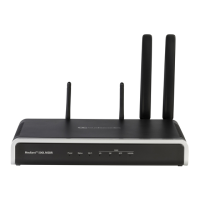User's Manual 224 Document #: LTRT-10466
Mediant 500L MSBR
5. In the 'RADIUS VSA Vendor ID' field, enter the same vendor ID number as set on the
RADIUS server.
6. When implementing Web user access levels, do one of the following:
• If the RADIUS server response includes the access level attribute: In the
'RADIUS VSA Access Level Attribute' field, enter the code that indicates the
access level attribute in the VSA section of the received RADIUS packet. For
defining the RADIUS server with access levels, see ''Setting Up a Third-Party
RADIUS Server'' on page 222.
• If the RADIUS server response does not include the access level attribute:
In the 'Default Access Level' field, enter the default access level that is applied to
all users authenticated by the RADIUS server.
7. Configure RADIUS timeout handling:
a. From the 'Behavior upon Authentication Server Timeout' drop-down list, select
the option if the RADIUS server does not respond within five seconds:
♦ Deny Access: device denies user login access.
♦ Verify Access Locally: device checks the username and password
configured locally for the user (in the Web User Accounts page or Web
Users table), and if correct, allows access.
b. In the 'Password Local Cache Timeout' field, enter a time limit (in seconds) after
which the username and password verified by the RADIUS server becomes
invalid and a username and password needs to be re-validated with the RADIUS
server.
c. From the 'Password Local Cache Mode' drop-down list, select the option for the
local RADIUS password cache timer:
♦ Reset Timer Upon Access: upon each access to a Web page, the timer
resets (reverts to the initial value configured in the previous step).
♦ Absolute Expiry Timer: when you access a Web page, the timer doesn’t
reset, but continues its count down.
8. Configure when the Web Users table must be used to authenticate login users. From
the 'Use Local Users Database' drop-down list, select one of the following:
• When No Auth Server Defined (default): When no RADIUS server is configured
(or as fallback if the server is inaccessible).
• Always: Always, but if not found, use the RADIUS server to authenticate the
user.
9. Click Submit, and then reset the device with a burn-to-flash for your settings to take
effect.
18.3.3 Securing RADIUS Communication
RADIUS authentication requires HTTP basic authentication (according to RFC 2617).
However, this is insecure as the usernames and passwords are transmitted in clear text
over plain HTTP. Thus, as digest authentication is not supported with RADIUS, it is
recommended that you use HTTPS with RADIUS so that the usernames and passwords
are encrypted.
To configure the device to use HTTPS, set the 'Secured Web Connection (HTTPS)'
parameter to HTTPS Only, in the Web Security Settings page (Configuration tab >
System menu > Management > Web Security Settings).

